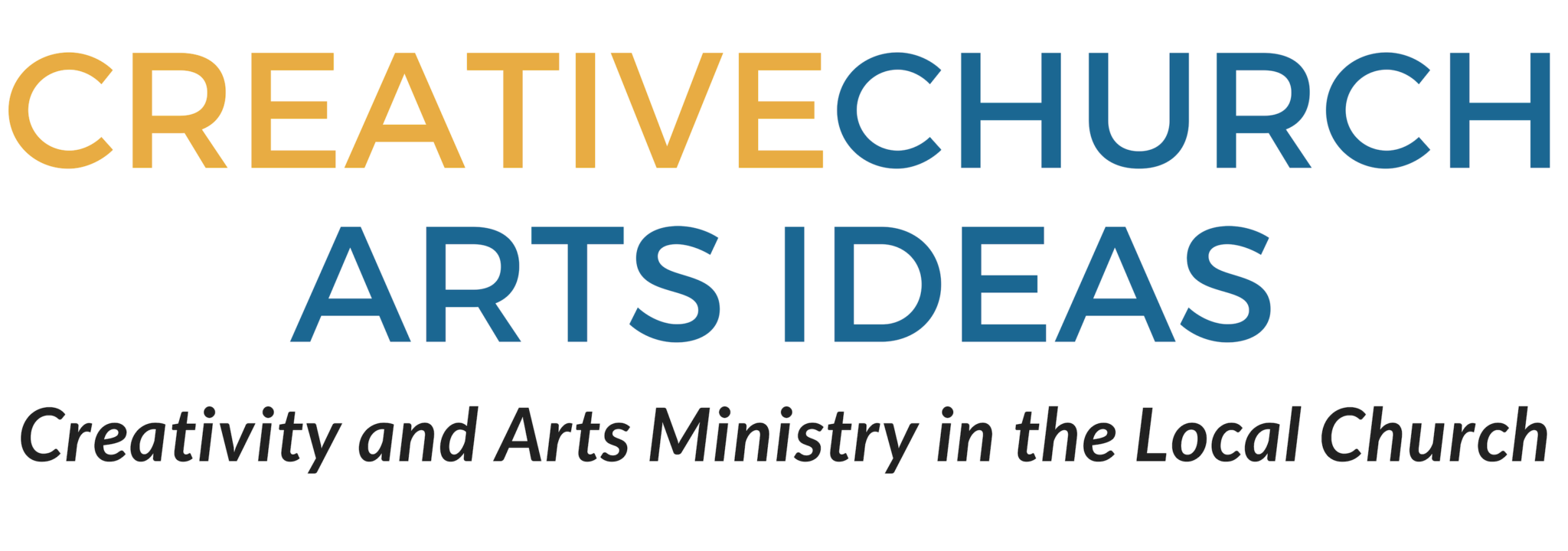(This project was conceived and contributed by Danica Thurber. Reach her at [email protected].)
Concept:
A guided art response to help a congregation understand and engage in honest prayer.
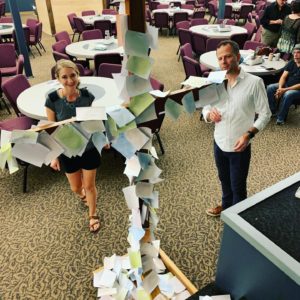
Background:
Cultivating a culture of genuine honesty is always difficult–in a congregation or in ourselves. When it comes to honesty in prayer, many find themselves holding back. This exercise was done for around 450 people during the message time in a regular Sunday service. After the opening worship set, the pastor used Psalm 73 to introduce the idea of honest prayer. The Message version was used to show the unadorned, straightforward honesty of the writer. The artist facilitator then led the congregation in discovering their honest prayer, expressing it through a crayon-resist art project, and then inviting a response of surrendering the prayer project before the cross.
This art project is simplified and streamlined so that it can be done with a large group of people, taking 15 minutes maximum to complete all the steps.
How it Works:
Prepare supplies and set them out on tables beforehand. The steps are simple actions, with time allotted for each step. After the step is complete, the artist facilitator or pastor may say a few words to describe the symbolism or value of each step. Suggestions are written in italics.
To begin, acknowledge the art supplies on each table, but encourage the congregation to not touch the supplies until directed.
1) (3-5 min. total) Lead the church in discovering their honest prayer. Ask a question such as, “What are the prayers or thoughts that you would normally censor before God?” Some people will know right away, but others might need help in discovering their honest prayers for themselves. A slide with examples is helpful in this case. I used a slide that listed honest prayers/thoughts I got from the Message translation of Psalm 73. In the same 5 min., enco
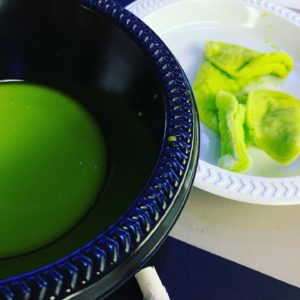
urage the congregation to boil it down to just one word, image, or a phrase. Remind them to just hold it in their mind for a minute. Complete this activity in quiet, with music in the background. (Your congregation may need less time. It is wise to wait 3 min. See if they need more time)
After this step is completed, *Affirm that God wants to hear these unedited, honest prayers.*
2) (3 min. total) Lead the church in writing down their word, phrase, or image using white crayon. Ask them to press mildly hard so that the crayon-resist technique works better.
After this step is completed, explain the significance of the white crayon. For example:
*Notice these prayers often go unspoken because we think they’re inappropriate to express. God longs to hear our honest prayers. He wants us to bring the very thoughts we deemed so bad right up to him. We’re going to practice that today.*
3) (3 min. total) Lead the church in making the prayers visible using watercolor paint. Demonstrate dipping a cotton round in a bowl of watercolor paint, then swiping it across the white crayon to reveal their prayer. They can repeat these watercolor layers if they want it darker. Deposit dirty cotton rounds on the disposable plates on each table. Add any additional cleaning/care instructions to fit your facility’s needs.
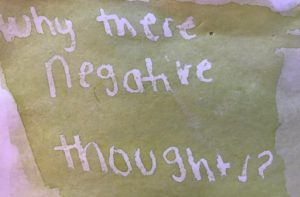
After this step is completed, explain the significance of making their prayers visible. For example:
*Maybe seeing the raw honest thoughts makes you feel a tad uncomfortable or ashamed. But God longs to hear our honest prayers – yes, that same one you wrote and painted out! I’m going to invite you into something brave today. God invites us to bring the thoughts we deemed so ugly right up to him, to the cross. And so we’re going do just that.*
4) (Variable time) Invite the church to bring their finished pieces up to a cross or altar as an act of surrender. When we did it, we had a wooden cross. We used thumb tacks to attach the prayers, covering the cross entirely. This part can be done with background music, or with the closing worship set going in the background. Plan timing according to your facility, church size, or the ease of flow with bringing the art projects up to the front.
Sample phrasing for inviting people into surrender (notice the option to decline):
*We’ll play another worship set, and as you feel its time, bring your painting up to this cross and I’ll help you attach it. Among all of the other pieces, no one will know it’s yours! If you’d like to remain seated and keep your painting with you, that’s ok. I do hope you’ll take some time this week to offer up your raw prayers to Father God in private. We’ll begin the worship and together as a church, let’s surrender our raw, honest prayers to the One who already knows, and to the only One who can truly handle them. Come on up when you’re ready.*
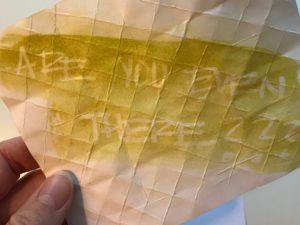
5) The end conclusion can be made by the pastor, worship leader, or the artist facilitator. The idea is to wrap up the significance of the surrender of honest prayers at the cross. Communion is also a wonderful conclusion to this response. Instructions can also be made for cleanup.
Sample phrasing:
*We do this together as a symbolic act. All of our raw honest prayers find their answer in Jesus (give examples here). There is no sin, no slander, no violence beyond the reach of his love.*
Result:
This activity results in a helpful and guided application of a message about honesty in prayer. The invitation to surrender the honest prayer is a powerful activity, both for the individual, and for the congregation as a whole. It is a shared experience that results in an end display of both solidarity (in honesty and shared pain) and surrender. When we did this response, the staff was amazed at the number of people who came up to surrender their prayer. The final effect of the cross covered in honest prayers was beautiful and powerful.
Details:
- This activity should be done at tables (not rows of chairs), with 4-8 chairs at each table.
- Set tables with supplies before people are seated.
- Each step can precede with a warning to listen to the instruction before beginning to complete the step. This minimizes sound, as well as the need to repeat yourself.
- Each table only needs one bowl (therefore, one color) of diluted watercolor paint. Our church chose to use five different colors, distributed between 100 tables. When everyone brought their prayer to the front, the varied colors made a beautiful display.
- The watercolor supplies in this project are simplified for use in a large and mixed–ability congregation. It was also a cost-efficient way to facilitate this
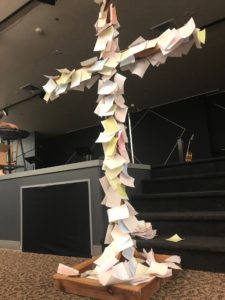 project en masse. If you have a small or artistically skilled congregation, you can substitute cotton rounds and paint bowls for actual brushes, cups of water, and watercolor paints in hard pads. This may require additional instruction and time, so plan accordingly for step 3.
project en masse. If you have a small or artistically skilled congregation, you can substitute cotton rounds and paint bowls for actual brushes, cups of water, and watercolor paints in hard pads. This may require additional instruction and time, so plan accordingly for step 3. - As part of the message preceding the art project, our pastor showed clips of a video with Eugene Peterson talking with U2’s Bono about honesty and the arts. The video was a great way to setup the value of the activity the congregation is about to do. It can be found here: https://www.youtube.com/watch?v=-l40S5e90KY&t=878s
Materials Needed:
Stage setup:
A wooden cross or altar should be set up front, but not on the stage (gives easy access for people to come up). If your step 4 includes using pushpins to attach artwork to a wooden cross, you can place a box of pins by near the cross.
To prepare 1 watercolor bowl for each table:
- Plastic pitcher (use one pitcher for each color you are mixing)
- Disposable bowl (one for each table)
- Watercolors in a tube (0.2 fluid ounces of watercolor pigment for every 1 cup of water)
- Mixing stick or spoon
 Each watercolor bowl should be filled with ¼ cup of diluted watercolor. Calculate how many cups you need so that each table has one bowl. Additionally, you will need about 0.2 fluid ounces of watercolor pigment for every 1 cup of water. Mix the watercolor and the water in a plastic pitcher using a mixing stick or spoon. Make sure the watercolor paint is dissolved well. Use the pitcher to pour ¼ cup of the watercolor mixture into each bowl.
Each watercolor bowl should be filled with ¼ cup of diluted watercolor. Calculate how many cups you need so that each table has one bowl. Additionally, you will need about 0.2 fluid ounces of watercolor pigment for every 1 cup of water. Mix the watercolor and the water in a plastic pitcher using a mixing stick or spoon. Make sure the watercolor paint is dissolved well. Use the pitcher to pour ¼ cup of the watercolor mixture into each bowl.
(If you want to use several colors, mix the appropriate amount in separate pitchers.)
Each table should have:
- A shallow, disposable bowl of watercolor paint (see above).
- White crayons (these can be ordered in bulk online). Two per table is fine. I asked tables to share and pass the crayons around their table.
- A small piece of cardstock for each person at the table. Each sheet should be about a fourth size (approx. 4×5.5”). You can also use watercolor paper if cost allows.
- 1-2 cotton rounds for each person at the table. These can easily be found at drug stores or in the beauty section.
- A disposable plate, bag, or garbage bin to collect used cotton rounds at each table.
Danica Thurber is based in Boise, Idaho where she helps others work through their own personal stories, especially of grief, by teaching art as a tool for self-expression, reflection, processing, and sharing. Contact her at: [email protected]. Visit her website at: http://Danicatheartist.com
Do you have a church arts project to share? Contribute your creative church arts projects and ideas HERE.
